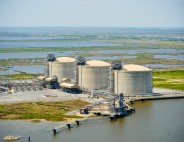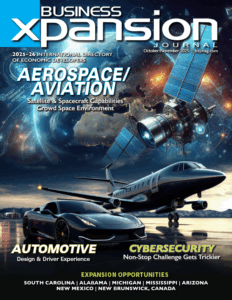Automotive Industry is Smarter and Lighter
13 Jan, 2014
By Rachel Duran
Intelligent transportation systems and mass reduction propel auto design and engineering.
It is believed in the future that the majority of vehicles on the road will be driven autonomously by communicating with networks operating from the cloud. Organizations, including automakers and Google, are already testing these connected vehicles.
Before these transformations in mobility become commonplace; however, R&D initiatives and test centers continue to ramp up intelligent transportation systems initiatives to get us there. What’s more, there are also near term mandates that must be met to achieve fuel economy and lower CO2 emissions. Lowering the weight of vehicles is a primary path to achieve those goals.
Private and public sector partnerships may be one key to the automotive industry’s evolution. Today, the focus in automotive design and engineering includes a variety of initiatives. Below are a few of the activities:
*creating additional embedded safety technologies
*developing additional uses for the immense amount of data vehicles already collect, such as creating applications to address environmental concerns
*creating secure cloud networks to support autonomously driven vehicles
*lightweighting vehicles is the primary path to achieve Corporate Average Fuel Economy (CAFE) fuel economy and emissions mandates, which includes manufacturing mixed-materials vehicles
Driving Assist Systems
Economic development officials in Ann Arbor, Mich., are leveraging the region’s assets in automotive design and engineering to become the hub for the next generation of vehicle testing. The community is home to the University of Michigan’s Transportation Research Institute, which has been conducting mobility tests on 3,000 cars, trucks and busses. The vehicles are outfitted with telemetry and communication devices.
The university has launched a mobility transportation center, which is part of a $25 million study by the U.S. Department of Transportation. Among its initiatives, the new center will build on traditional testing methods such as driving cars on test tracks, navigating a variety of road conditions. The onset of new technologies takes the testing to the next level, testing and creating standards for how vehicles will talk to each other, how they will talk to the roadways, and securing communications of the vehicles to the cloud. “The mobility testing is primarily in the area of safety, alerting drivers to potential crash situations by communication from the roadway and other vehicles,” says Paul Krutko, CEO, Ann Arbor SPARK. Part of the group’s efforts focus on creating and supporting a robust entrepreneurial business climate.
Along the same lines as the mobility center, on a larger scale, is a proposed connected-vehicle research center that will retrofit a former GM powertrain manufacturing facility called Willow Run. The consortium is led by Ann Arbor SPARK and includes RACER Trust (overseers of GM’s bankruptcy), Devon Industrial Group and Walbridge Development. “Our intent is to redevelop as a faux city environment because what is important now is how you are testing technology as vehicles are going between buildings and different roadway configurations,” Krutko says. “We need to demonstrate this because you can’t create standards and make sure the technology works by just putting it out there on the road. You have to build a new environment.”
Officials want to create an open source testing environment where different companies can work on projects together. “And they may not necessarily be auto companies due to the convergence between ICT and automotive,” Krutko says. “This builds on our historical strengths as the preeminent automotive center in the world, and also the fact that we have assets to position the region well to bring these two areas together as we look at what is next in transportation.”
Ann Arbor’s history in automotive design and engineering goes back to the establishment of a U.S. EPA testing facility several decades ago. Over time, a variety of nameplates from throughout the world located some type of facility in Ann Arbor to test their cars at the EPA facility.
An example is the Toyota Technical Center (TTC), a division of Toyota Motor Engineering & Manufacturing, North America Inc. Krutko says the company designs and tests every one of its vehicles for sale in the North American market from Ann Arbor. The company recently announced a $28 million expansion for its two design facilities in the community.
“Our expansion of transmission development capability in Ann Arbor is to develop more competitive vehicles,” writes Brian Schneidewind, general manager, Hybrid Vehicle & Drivetrain, TTC, in an email correspondence. “Different from the rest of the world, the North American market is dominated by stepped automatic transmissions. By utilizing our local North American technology, North American manufacturing, and North American customer voice, we can contribute in the development of transmission design, evaluation, and calibration to build better vehicles.”
The TTC team is also actively involved in developing intelligent transportation systems for the North American market. They have validated and evaluated advanced driving assist systems (ADAS) products in the North American driving environment, notes Hideki Hada, general manager in the Electronic Systems Response section of TTC. The team demonstrated vehicle-to-vehicle and vehicle-to-infrastructure concepts at the 2008 ITS World Congress. Examples include the development of blind spot monitor, and rear cross-traffic alert, which are now available in many Toyota and Lexus models, Hada writes.
Collaborative efforts are embraced by Toyota. Its vehicle-to-vehicle and vehicle-to-infrastructure systems work well with vehicles from other automotive manufacturers. Toyota is part of a number of collaborations with other OEMs and government agencies under the Crash Avoidance Metrics Partnership’s Vehicle Safety Communications Consortium, and the Vehicle Infrastructure Integration Consortium. Working jointly with other OEMs, the company has conducted proof-of-concept and validation of these systems with a variety of organizations, reflecting industry standards set by SAE International and IEEE, Hada notes.
Skinny Cars
Automotive designers and engineers are also working to lower the weight of vehicles to meet fuel economy standards set under CAFE, which requires manufacturers of light duty vehicles to reach 54.5 miles per gallon of gas by 2025. This standard essentially doubles fuel economy, says Dr. Jay Baron, president and CEO, Center for Automotive Research (CAR), located in Ann Arbor. “Lightweighting with/through materials and design optimization was identified as one of the major technologies to get there,” Baron says.
The mass reductions can come from downsizing the engine and from the use of new materials. One approach to lightweighting vehicles is to utilize mixed-material solutions, where the three major materials include steel, aluminum and composites. Other materials include titanium and magnesium. A mixed-materials environment will emerge as the perhaps the largest single sector in the automotive design space for the next 15 years, says Doug Richman, vice president of engineering and technology, Kaiser Aluminum. The company manufactures extruded aluminum products.
Each of the three main materials offers opportunities to lower the weight of cars, Baron notes, and each comes with pros and cons. “The point is a car is a mixture of all three materials,” he says. “We want to make sure the auto industry introduces new lightweight solutions as fast as possible, and make sure the supply chain is ready when it is needed.”
As a result, CAR has formed the Coalition for Automotive Lightweighting Materials (CALM) initiative to bring the suppliers of these materials including designers, fabricators and material providers together in order to meet their goals. The steering committee includes CAR, the Aluminum in Transportation Group of the Aluminum Association Inc., and the American Chemistry Council Inc. CALM has strong representation from aluminum and composites industry members; steel fabricators participate, but not the steel companies themselves.
Working together, industry members have found applications in a car where one material will enable another material. For example, sophisticated adhesives made by the composites industry allow composite parts to bond with aluminum parts, and aluminum parts to bond to steel parts by using joining technologies (rivets and adhesives) as opposed to the traditional resistant spot welding.
“We need to make sure we are bringing new and plausible lightweight solutions for components and parts to the auto industry to assist in lightweighting vehicles because striving for CAFE is the most important thing for manufacturers,” adds Gina Oliver, senior director, the automotive group in the plastics division of the American Chemistry Council Inc.
Baron says the members of CALM are co-developing projects to identify challenges, document best practices, and develop the business case including cost and production solutions — regardless of the materials used — developing the lightest mixture of materials as cost effectively as possible.
“With a coalition of this type you can command a broader audience at the auto companies or even large Tier I companies,” Baron says. “You can reach the right people to get the answers to what the barriers are so they can go back to their technical centers with what they need to work on.”
Krutko points out an effort along these lines taking place at the Lotus Engineering facility in Ann Arbor. The company has a contract with the California Air Resource Board to design what vehicles might look like in terms of materials and structure 20 years to 30 years from now. “They are working separate and apart from OEMs, advanced technologies that various auto OEMs can incorporate into their vehicles,” Krutko says. “What is interesting is this activity is going across disciplines where they might have been separate before due to lightweighting materials.”
Baron says of the CALM initiative: “Working as a team, we can go to some of the federal agencies, such as DoE, and demonstrate that we want to work on this as a team, bringing our expertise together. We like to call this advancing the technology.”
How will lightweighting move the automotive industry forward? “My personal projection, in the short term, being the next five to 10 years, is that we will see an aggressive use of very high strength steel, and a lot more aluminum,” Baron says. “We will reduce vehicle weight by 10 percent to 12 percent in the next five to 10 years, which is a reduction of 400 pounds. By 2025 you will see more aggressive use of composites that will get additional weight out of the vehicle, probably another 5 percent.” Additional use of lightweighting will continue after 2025 with more aggressive use of lightweighting materials.
Lighter and smarter cars are on the horizon. Industry and public partnerships and collaborations will be critical to creating open source testing environments in which different companies can work on developments to move the automotive sector toward its next phase.
For complete details about the organizations featured in this article, visit:
American Chemistry Council Inc.’s Plastics Division, Auto Industry
Center for Automotive Research in Ann Arbor, Mich.
Coalition for Automotive Lightweighting Materials
Illustration by at Free Digital Photos.net
Port of Baltimore is No. 1 for Auto Movements
By Rachel Duran
For the third year in a row, the Port of Baltimore has been named the No. 1 automotive port based on volume in the country. In 2012, the port handled 652,000 vehicles; officials expect to meet that number again in 2013.
In 2013, the port added Mazda to its roster of automotive companies. Fiat will begin moving cars from the port soon. “For the first time in 30 years Fiats will come into the United States, through the Port of Baltimore,” says Larry Johnson, director of trade development-automotive, Port of Baltimore.
The port handles imports and exports of automobiles for nearly all of the automotive manufacturing companies in the world. These OEMs range from Lamborghinis to Hondas to Fords to Chrysler, and so on. These companies benefit from the port’s strategic Mid-Atlantic inland location, which provides shorter distances between manufacturer, port and market, making exports a day closer.
The majority of the port’s largest marine terminal, Dundalk, is dedicated to moving automobiles. “We have four processors,” Johnson says. “The services we offer have greatly enhanced the volumes that pass through here.” Cars come off a ship and are staged at processors, who then add accessories such as navigation and satellite systems, floor mats, spoilers, and tube lighting, among other add-ons.
Beyond these services, the port’s officials have created a unique program called Quality Cargo Handling Action Team or QCHAT. “We believe we are the only port in the U.S. that has this program, where we bring all the people in the supply chain together to go over what is working and not working, on a regular basis,” says Richard Scher, director of communications, Port of Baltimore. The members review check lists to gauge their progress in meeting quality standards when handling the cars.
“The supply chain functions at a high level here,” Johnson says.
For complete details, visit www.mpa.maryland.gov.
Related Posts
-

Ready to Shift into High Gear
-

Auto Industry Riding High
-

Manufacturing Combats Workforce Uncertainties
-

Oil and Gas Seek Growth Despite Volatility
-

Partners in the Great Outdoors
-

Auto OEMs Deal With Changes in How We Move
-

Headquarters Expand Their Horizons
-

Arts Scene Complements the Innovation Economy
-

Natural Assets Inspire Innovations in Recreation Economy
-

Appetites Return to Food Processing









